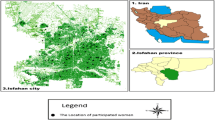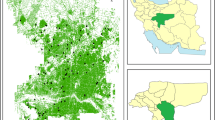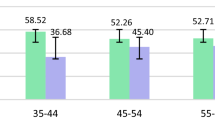Abstract
Purpose
Heavy metals, as significant toxic environmental contaminants, can cause serious adverse health outcomes on the human body even in trace concentrations. There is limited evidence on heavy metal concentrations existing in the body fluids of pregnant women. This study aims to evaluate the urinary levels of arsenic (As) and lead (Pb), as two main toxic heavy metals, among pregnant women and their lifestyle determinants.
Methods
The study was performed in 2019–2020 in Isfahan, Iran. A number of 140 urine samples of pregnant women who were in their first pregnancy trimester were examined. Inductively coupled plasma optical emission spectrometry (ICP-OES) was applied to analyze the urinary concentrations of As and Pb. Socio-demographic data including age, pre-pregnancy body mass index (BMI), education status, and family income, as well as the use of cleaning products (cosmetic and household cleaning products), and lifestyle habits (food intake, smoking, and physical activity) were collected using a validated questionnaire.
Results
The mean concentration of As and Pb were 8.14 ± 10.8 and 9.6 ± 7.1 μg/g creatinine, respectively. The mean urinary concentration of Pb indicated significant differences in the levels of cosmetic usage, second-hand smoking exposure, and the use of Copper, Aluminum, Teflon, Steel, and Enameled utensils for cooking (p-value < 0.05). Furthermore, the mean of urinary Pb concentrations at high levels of physical activity and scratched utensils using was significantly different from the other categories (p-value = 0.02). No significant differences were found between As and Pb concentration with other socio-demographic factors.
Conclusion
The lifestyle determinants and cosmetic products use are important predictors of urinary heavy metals in pregnant women, rather than sociodemographic characteristics. Additional research is necessary to determine long-term adverse birth outcomes of exposure to these heavy metals.

Similar content being viewed by others
References
Tchounwou PB, Yedjou CG, Patlolla AK, Sutton DJ. Heavy metal toxicity and the environment. In: Luch A, editor. Molecule, clinic environ toxicol. Basel: Springer; 2012. p. 133–64.
Mohammadi H, Alinejad A, Khajeh M, Darvishmotevalli M, Moradnia M, Mazaheri Tehrani A, Hosseindost G, Zare MR, Mengelizadeh N. Optimization of the 3D electro-Fenton process in removal of acid orange 10 from aqueous solutions by response surface methodology. J Chem Technol Biotechnol. 2019;94(10):3158–71.
Moradnia M, et al. The relation of cancer risk with nitrate exposure in drinking water in Iran. Iran J Public Health. 2019;48(2):362–4.
Gollenberg AL, Hediger ML, Lee PA, Himes JH, Buck Louis GM. Association between lead and cadmium and reproductive hormones in peripubertal US girls. Environ Health Perspect. 2010;118(12):1782–7.
Gundacker C, Fröhlich S, Graf-Rohrmeister K, Eibenberger B, Jessenig V, Gicic D, et al. Perinatal lead and mercury exposure in Austria. Sci Total Environ. 2010;408(23):5744–9.
Egorova KS, Valentine PA. Toxicity of metal compounds: knowledge and myths. Organometallics. 2017;36(21):4071–90.
Milton AH, Hussain S, Akter S, Rahman M, Mouly TA, Mitchell K. A review of the effects of chronic arsenic exposure on adverse pregnancy outcomes. Int J Environ Res Public Health. 2017;14(6):556.
Khlifi R, Olmedo P, Gil F, Feki-Tounsi M, Hammami B, Rebai A, et al. Biomonitoring of cadmium, chromium, nickel and arsenic in general population living near mining and active industrial areas in Southern Tunisia. Environ Monit Assess. 2014;186(2):761–79.
Vahter M. Health effects of early life exposure to arsenic. Basic Clin Pharmacol Toxicol. 2008;102(2):204–11.
Fadaei S, Noorisepehr M, Pourzamani HR, Salari M, Moradnia M, Darvishmotevalli M, Mengelizadeh N. Heterogeneous activation of peroxymonosulfate with Fe3O4 magnetic nanoparticles for degradation of Reactive Black 5: Batch and column study. J Environ Chem Eng. 2021;9(4):105414.
Neeti K, Prakash T. Effects of heavy metal poisoning during pregnancy. Int Res J Environ Sci. 2013;2(1):88–92.
Spielmann H. The toxicity of heavy metals in the pregnant woman, fetus and newborn infant. In: Health evaluation of heavy metals in infant formula and junior food. Berlin: Springer; 1983. p. 57–68.
Huang Y, Li J, Garcia JM, Lin H, Wang Y, Yan P, et al. Phthalate levels in cord blood are associated with preterm delivery and fetal growth parameters in Chinese women. PloS One. 2014;9(2):e87430.
Magnusson C, Jugdaohsingh R, Hulthen L, Westerlund A, Powell JJ, Ransjö M. Urinary excretion of silicon in men, non-pregnant women, and pregnant women: a cross-sectional study. Biol Trace Elem Res. 2019;194:1–7.
Quansah R, Armah FA, Essumang DK, Luginaah I, Clarke E, Marfoh K, et al. Association of arsenic with adverse pregnancy outcomes/infant mortality: a systematic review and meta-analysis. Environ Health Perspect. 2015;123(5):412–21.
Taherkhani S, Darvishmotevalli M, Karimyan K, Bina B, Fallahi A, Karimi H. Dataset on photodegradation of tetracycline antibiotic with zinc stannate nanoflower in aqueous solution–Application of response surface methodology. Data Br. 2018;19:1997–2007.
Moradnia M, Emamjomeh MM. An environmental-friendly study on sanitary wastewater treatment for small community. Desalin Water Treat. 2017;94:25–30.
Darvishmotevalli M, Moradnia M, Asgari A, Noorisepehr M, Mohammadi H. Reduction of pathogenic microorganisms in an Imhoff tank–constructed wetland system. Desalin Water Treat. 2019;154:283–8.
Moradnia M, Movahedian Attar H, Heidari Z, Mohammadi F, Kelishadi R. Prenatal exposure to chromium (Cr) and nickel (Ni) in a sample of Iranian pregnant women: urinary levels and associated socio-demographic and lifestyle factors. Environ Sci Pollut Res. 2021. https://doi.org/10.1007/s11356-021-15201-w.
Asgari G, Mohammad Gholi Mezerji N, Salari M, Asgharnia HA, Darvishmotevalli M, Faraji H, Moradnia M. Forecasting nitrate concentration in babol groundwater resources using the grey model. Int J Env Health Eng. 2020;9(1):16.
Hajizadeh Y, Moradnia M, Feizabadi GK, Rafiei N, Tahmasbizadeh M, Darvishmotevalli M, et al. The sex-specific association between maternal urinary paraben levels and offspring size at birth. Environ Sci Pollut Res. 2021;28(27):36029–38.
Darvishmotevalli M, Bina B, Feizi A, Ebrahimpour K, Pourzamani H, Kelishadi R. Monitoring of urinary phthalate metabolites among pregnant women in Isfahan, Iran: the PERSIAN birth cohort. J Environ Health Sci Eng. 2019;17(2):969–78.
Darvishmotevalli M, Moradnia M, Noorisepehr M, Fatehizadeh A, Fadaei S, Mohammadi H, et al. Evaluation of carcinogenic risks related to nitrate exposure in drinking water in Iran. MethodsX. 2019;6:1716–27.
Sepehr MN, Allani F, Zarrabi M, Darvishmotevalli M, Vasseghian Y, Fadaei S, Fazli MM. Dataset for adsorptive removal of tetracycline (TC) from aqueous solution via natural light weight expanded clay aggregate (LECA) and LECA coated with manganese oxide nanoparticles in the presence of H2O2. Data Br. 2019;22:676–86.
Hajizadeh Y, Ebrahimpour K, Shoshtari-Yeganeh B, Fadaei S, Darvishmotevalli M, Karimi H. Urinary paraben concentrations and their implications for human exposure in Iranian pregnant women. Environ Sci Pollut Res. 2020;27(13):14723–34.
Lewis RC, Meeker JD, Basu N, Gauthier AM, Cantoral A, Mercado-García A, et al. Urinary metal concentrations among mothers and children in a Mexico City birth cohort study. Int J Hyg Envir Heal. 2018;221(4):609–15.
Darvishmotevalli M, Moradnia M, Hosseini R, Bina B, Feizi A, Ebrahimpour K, et al. Association between prenatal phthalate exposure and anthropometric measures of newborns in a sample of Iranian population. Environ Sci Pollut Res. 2021;28:1–11.
Cleland C, Ferguson S, Ellis G, Hunter RF. Validity of the international physical activity questionnaire (IPAQ) for assessing moderate-to-vigorous physical activity and sedentary behaviour of older adults in the United Kingdom. BMC Med Res Methodol. 2018;18(1):176.
Poustchi H, Eghtesad S, Kamangar F, Etemadi A, Keshtkar A-A, Hekmatdoost A, et al. Prospective epidemiological research studies in Iran (the PERSIAN Cohort Study): rationale, objectives, and design. Am J Epidemiol. 2018;187(4):647–55.
Feng W, Cui X, Liu B, Liu C, Xiao Y, Lu W, et al. Association of urinary metal profiles with altered glucose levels and diabetes risk: a population-based study in China. PloS One. 2015;10(4):e0123742.
Rocha G, Steinbach C, Munhoz J, Madia M, Faria J, Hoeltgebaum D, et al. Trace metal levels in serum and urine of a population in southern Brazil. J Trace Elem Med Biol. 2016;35:61–5.
Shirai S, Suzuki Y, Yoshinaga J, Mizumoto Y. Maternal exposure to low-level heavy metals during pregnancy and birth size. Environ Sci Pollut Res Int Part A. 2010;45(11):1468–74.
Al-Saleh I, Shinwari N, Mashhour A, Mohamed GED, Rabah A. Heavy metals (lead, cadmium and mercury) in maternal, cord blood and placenta of healthy women. Int J Hyg Environ Health. 2011;214(2):79–101.
Fort M, Cosín-Tomás M, Grimalt JO, Querol X, Casas M, Sunyer J. Assessment of exposure to trace metals in a cohort of pregnant women from an urban center by urine analysis in the first and third trimesters of pregnancy. Environ Sci Pollut Res. 2014;21(15):9234–41.
Baron R, Manniën J, de Jonge A, Heymans MW, Klomp T, Hutton EK, et al. Socio-demographic and lifestyle-related characteristics associated with self-reported any, daily and occasional smoking during pregnancy. PLoS One. 2013;8(9):e74197.
Weidenhamer JD, Kobunski PA, Kuepouo G, Corbin RW, Gottesfeld P. Lead exposure from aluminum cookware in Cameroon. Sci Total Environ. 2014;496:339–47.
Orisakwe OE, Nduka JK, Amadi CN, Dike DO, Bede O. Heavy metals health risk assessment for population via consumption of food crops and fruits in Owerri, South Eastern, Nigeria. Chem Central J. 2012;6(1):77.
Zeng X, Xu X, Qin Q, Ye K, Wu W, Huo X. Heavy metal exposure has adverse effects on the growth and development of preschool children. Environ Geochem Health. 2019;41(1):309–21.
Zaw YH, Taneepanichskul N. Blood heavy metals and brain-derived neurotrophic factor in the first trimester of pregnancy among migrant workers. PloS One. 2019;14(6):e0218409.
Lin Z, Chen X, Xi Z, Lin S, Sun X, Jiang X, et al. Individual heavy metal exposure and birth outcomes in Shenqiu county along the Huai River Basin in China. Toxicol Res. 2018;7(3):444–53.
Wenzel AG, Brock JW, Cruze L, Newman RB, Unal ER, Wolf BJ, et al. Prevalence and predictors of phthalate exposure in pregnant women in Charleston, SC. Chemosphere. 2018;193:394–402.
Wai KM, Mar O, Kosaka S, Umemura M, Watanabe C. Prenatal heavy metal exposure and adverse birth outcomes in Myanmar: a birth-cohort study. Int J Environ Res Public Health. 2017;14(11):1339.
Chang CH, Liu CS, Liu HJ, Huang CP, Huang CY, Hsu HT, et al. Association between levels of urinary heavy metals and increased risk of urothelial carcinoma. Int J Urol. 2016;23(3):233–9.
DiBenedetto MK, Schunk DH. Self-efficacy in education revisited through a sociocultural lens. Big Theor Revisit. 2018;2(1):117.
Amadi CN, Igweze ZN, Orisakwe OE. Heavy metals in miscarriages and stillbirths in developing nations. Middle East Fertil Soc J. 2017;22(2):91–100.
Yang Y, Liu H, Xiang X-h, Liu F-y. Outline of occupational chromium poisoning in China. Bull Environ Contam Toxicol. 2013;90(6):742–9.
Chien L-C, Han B-C, Hsu C-S, Jiang C-B, You H-J, Shieh M-J, et al. Analysis of the health risk of exposure to breast milk mercury in infants in Taiwan. Chemosphere. 2006;64(1):79–85.
Turan K, Arslan A, Uçkan K, Demir H, Demir C. Change of the levels of trace elements and heavy metals in threatened abortion. Chin Med J. 2019;82(7):554–7.
García-Esquinas E, Pérez-Gómez B, Fernández MA, Pérez-Meixeira AM, Gil E, de Paz C, et al. Mercury, lead and cadmium in human milk in relation to diet, lifestyle habits and sociodemographic variables in Madrid (Spain). Chemosphere. 2011;85(2):268–76.
Dan EU, Ebong GA. Impact of cooking utensils on trace metal levels of processed food items. Ann Food Sci Technol. 2013;14(2):350–5.
Cabrera C, Lloris F, Gimenez R, Olalla M, Lopez MC. Mineral content in legumes and nuts: contribution to the Spanish dietary intake. Sci Total Environ. 2003;308(1–3):1–14.
Kuligowski J, Halperin KM. Stainless steel cookware as a significant source of nickel, chromium, and iron. Arch Environ Contam Toxicol. 1992;23(2):211–5.
Said SA. The impact of using the scratched utensil on food contamination with heavy metals. IOSR J Environ Sci. 2015;9(5):2319–99.
Castro-González M, Méndez-Armenta M. Heavy metals: Implications associated to fish consumption. Environ Toxicol Pharmaco. 2008;26(3):263–71.
Ajaezi GC, Amadi CN, Ekhator OC, Igbiri S, Orisakwe OE. Cosmetic use in Nigeria may be safe: a human health risk assessment of metals and metalloids in some common brands. J Cosmet Sci. 2018;69(6):429–45.
Kohli NJV. Here are other celebs who said no to endorsements on ethical grounds. SCOOPWHOOP. 2017;14:2017.
Mohammed T, Mohammed E, Bascombe S. The evaluation of total mercury and arsenic in skin bleaching creams commonly used in Trinidad and Tobago and their potential risk to the people of the Caribbean. Public Health Res. 2017. https://doi.org/10.4081/jphr.2017.1097.
Nourmoradi H, Foroghi M, Farhadkhani M, Vahid Dastjerdi M. Assessment of lead and cadmium levels in frequently used cosmetic products in Iran. J Environ Public Health. 2013;2013:1–5.
Chiba M, Masironi R. Toxic and trace elements in tobacco and tobacco smoke. Bull World Health Organ. 1992;70(2):269.
Rzymski P, Tomczyk K, Poniedzialek B, Opala T, Wilczak M. Impact of heavy metals on the female reproductive system. Ann Agric Environ Med. 2015;22(2):259–64.
Mittal S. Smoking and tobacco use: Ill effects on reproductive, maternal, newborn, child health, and adolescent (RMNCHA) program—a review. Ann Natl Acad Med Sci. 2019;55(02):065–73.
Tetens I, Sjödin AM. Scientific opinion on health benefits of seafood (fish and shellfish) consumption in relation to health risks associated with exposure to methylmercury. EFSA J. 2014;12(7):3761.
Alidadi H, Dehghan A, Zamand S, Mohammadi A, Taghavimanesh V, Akbari SN. Evaluation the amount of lead, cadmium, mercury, nickel and tin in canned tuna fish available in Neyshabur markets in 2017. J Neyshabur Univ Med Sci. 2019;7(2):48–57.
Yu X-D, Yan C-H, Shen X-M, Tian Y, Cao L-L, Yu X-G, et al. Prenatal exposure to multiple toxic heavy metals and neonatal neurobehavioral development in Shanghai. China Neurotoxicol Teratol. 2011;33(4):437–43.
Blaurock-Busch E, Amin OR, Rabah T. Heavy metals and trace elements in hair and urine of a sample of Arab children with autistic spectrum disorder. Maedica. 2011;6(4):247–57.
Jaishankar M, Tseten T, Anbalagan N, Mathew BB, Beeregowda KN. Toxicity, mechanism and health effects of some heavy metals. Interdiscip Toxicol. 2014;7(2):60.
Jan AT, Azam M, Siddiqui K, Ali A, Choi I, Haq QMR. Heavy metals and human health: mechanistic insight into toxicity and counter defense system of antioxidants. Int J Mol Sci. 2015;16(12):29592–630.
Milnerowicz H, Nowak P, Wielogorska D, Wochynski Z, Sobiech K. Effects of moderate physical exercise on blood and urine concentrations of cadium and metallothionein in runners. Biol Sport. 2004;21(1):81–92.
Kawamura T, Muraoka I. Exercise-induced oxidative stress and the effects of antioxidant intake from a physiological viewpoint. Antioxidants. 2018;7(9):119.
Giimiistas MK. Lipid peroxidation, erythrocyte superoxide-dismutase activity and trace metals in young male footballers. Yonsei Med J. 2003;44(6):979–86.
Lauwerys RR, Bernard A. Early detection of the nephrotoxic effects of industrial chemicals: state of the art and future prospects. Am J Ind Med. 1987;11(3):275–85.
Acknowledgements
The authors are grateful to the team of the Department of Environmental Health Engineering, Isfahan University of Medical Sciences (IUMS)
Funding
This study was financially supported by Isfahan University of Medical Sciences. This paper was extracted from a PhD thesis funded by Isfahan University of Medical Sciences (IR.MUI.RESEARCH.REC.1399.065), and Project Number # 399025.
Author information
Authors and Affiliations
Corresponding author
Ethics declarations
Conflict of interest
The authors announce that they have no conflict of interest.
Additional information
Publisher’s note
Springer Nature remains neutral with regard to jurisdictional claims in published maps and institutional affiliations.
Rights and permissions
About this article
Cite this article
Moradnia, M., Movahedian Attar, H., Heidari, Z. et al. Monitoring of urinary arsenic (As) and lead (Pb) among a sample of pregnant Iranian women. J Environ Health Sci Engineer 19, 1901–1909 (2021). https://doi.org/10.1007/s40201-021-00743-5
Received:
Accepted:
Published:
Issue Date:
DOI: https://doi.org/10.1007/s40201-021-00743-5




